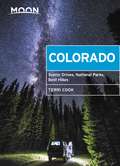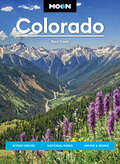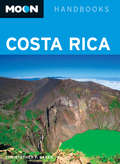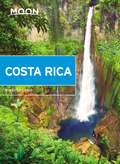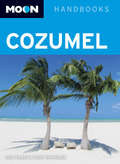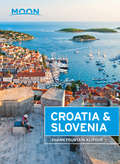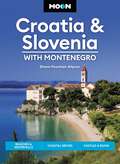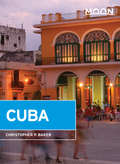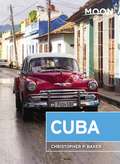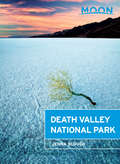- Table View
- List View
Moon Colorado: Scenic Drives, National Parks, Best Hikes (Travel Guide)
by Terri CookFrom hiking through red rock canyons and aspen forests to hitting the slopes, find your adventure with Moon Colorado. Inside you'll find:Strategic itineraries including a two-week road trip and quick getaways, with suggestions for outdoor adventurers, winter sports enthusiasts, history buffs, road-trippers, foodies, and moreThe top activities and unique experiences: Explore ancient pueblos or Wild West ghost towns, soak in a steaming hot spring, and spot wild elk, horses, and foxes. Savor fresh flavors at a farm-to-table restaurant and kick back with some of Colorado's delicious local microbrewsOutdoor adventures: Go white-water rafting or kayaking on a frothing river, and hike slickrock trails to awe-inspiring views of snow-capped mountain peaks. Ski the deep powder of some of the country's top resorts and relax with a delicious après-ski drinkFull-color photos and detailed maps throughoutHonest advice from Boulder local and lifelong adventurer Terri Cook on when to go, what to pack, and where to stay, from campsites and motels to B&Bs and resort lodgesReliable background on the culture, weather, wildlife, and history, plus tips on getting there and getting around by car, train, and public transportationRecommendations for families, LGBTQ+ travelers, seniors, international visitors, and travelers with disabilitiesFull coverage of Denver, Boulder and the Northern Front Range, Rocky Mountain National Park, Steamboat Springs and Northwest Colorado, Vail and the Central Rockies, Aspen and the Roaring Fork Valley, Mesa Verde and the Southwest, Colorado Springs and the SoutheastWith Moon's practical tips and local insight, you can experience the best of Colorado.Staying in the city? Try Moon Denver, Boulder & Colorado Springs. Staying in the park? Try Moon Rocky Mountain National Park. For an all-outdoors adventure, try Moon Colorado Camping.
Moon Colorado: Scenic Drives, National Parks, Hiking & Skiing (Moon U.S. Travel Guide)
by Terri CookFrom hiking through red rock canyons and aspen forests to hitting the slopes, find your adventure with Moon Colorado. Inside you'll find:Strategic itineraries for flexible one- to two-week road trips to experience the best of Colorado, from national parks to the Rocky Mountains The top activities and unique experiences: Explore ancient pueblos or Wild West ghost towns, soak in a steaming hot spring, and spot wild elk, horses, and foxes. Savor fresh flavors at a farm-to-table restaurant and kick back with delicious local microbrews Outdoor adventures: Go white-water rafting or kayaking on a rushing river, and hike slickrock trails to awe-inspiring views of snow-capped mountain peaks. Ski the deep powder of some of the country's top resorts and relax with an après-ski drink Full-color photos and detailed maps throughoutLocal insight from lifelong adventurer Terri Cook on when to go, what to pack, and where to stay, from campsites and motels to B&Bs and resort lodges Background information on the culture, weather, wildlife, and history, plus tips on getting there and getting around by car, train, and public transportation Recommendations for families, LGBTQ+ travelers, seniors, international visitors, and travelers with disabilities Comprehensive coverage of Denver, Boulder and the Northern Front Range, Rocky Mountain National Park, Steamboat Springs and Northwest Colorado, Vail and the Central Rockies, Aspen and the Roaring Fork Valley, Mesa Verde and the Southwest, Colorado Springs and the Southeast With Moon's practical tips and local insight, you can experience the best of Colorado. Staying in the city? Try Moon Denver, Boulder & Colorado Springs. Looking for outdoor adventures? Check out Moon Rocky Mountain National Park or Moon Colorado Camping. About Moon Travel Guides: Moon was founded in 1973 to empower independent, active, and conscious travel. We prioritize local businesses, outdoor recreation, and traveling strategically and sustainably. Moon Travel Guides are written by local, expert authors with great stories to tell—and they can't wait to share their favorite places with you. For more inspiration, follow @moonguides on social media.
Moon Columbia River Gorge & Mount Hood: Waterfalls & Wildflowers, Craft Beer & Wine, Hiking & Camping (Travel Guide)
by Matt WastradowskiWhether you're hiking past waterfalls and wildflowers or cruising past sweeping views of the Columbia River, experience the best of this wild corner of the country with Moon Columbia River Gorge & Mount Hood. Inside you'll find:Strategic, flexible itineraries, from day trips from Portland or weekend getaways from Vancouver to a road trip along the Fruit Loop, designed for outdoor adventurers, families, foodies and wine-lovers, and moreTop experiences, and things to do: Sip your way through Mount Hood's craft beer and wine scene while you take in views of the Gorge, sample fresh vegetables and cider from a local farm stand, or pick your own fruit for a picnic. Get an up-close look at the annual salmon run from the Bonneville Lock and Dam, and spend the night in the historic Timberline LodgeBest outdoor adventures for every season: Hike through fields of wildflowers and marvel at the towering cascades of Waterfall Alley. Make your way to the top of Beacon Rock for panoramic views of the Gorge, or hit the slopes of Mount Hood in the winter. Kayak or raft along the White Salmon River, soak in a hot spring surrounded by old-growth forest, and spend the night under the stars on the shores of a pristine lakeExpert advice on when to go, where to stay, and how to get around from seasoned outdoorsman and Bend local Matt WastradowskiHelpful resources on Covid-19 and traveling in OregonFull-color photos and detailed maps throughoutThorough background information on the landscape, climate, wildlife, and local cultureWith Moon Columbia River Gorge & Mount Hood's expert tips, local insight, and countless activities, you can plan your trip your way.Want more outdoor adventures in the PNW? Try Moon Pacific Northwest Hiking. About Moon Travel Guides: Moon was founded in 1973 to empower independent, active, and conscious travel. We prioritize local businesses, outdoor recreation, and traveling strategically and sustainably. Moon Travel Guides are written by local, expert authors with great stories to tell—and they can't wait to share their favorite places with you.For more inspiration, follow @moonguides on social media.
Moon Copenhagen & Beyond: Day Trips, Local Spots, Strategies to Avoid Crowds (Travel Guide)
by Michael BarrettWhether you're sipping coffee by a canal, exploring lavish palaces, or discovering the real meaning of hygge, get to know the Danish capital with Moon Copenhagen & Beyond.Explore In and Around the City: Meander through Copenhagen's most interesting neighborhoods, like the Inner City, Vesterbro, Nørrebro, and Christianshavn, and nearby areas, including Kronborg, Kongens Lyngby, Malmö, and moreGo at Your Own Pace: Choose from tons of itinerary options designed for foodies, history buffs, art lovers, and moreSee the Sights: Stroll cobbled streets and bike along picture-perfect canals, watch the changing of the guard at Amalienborg, picnic on the grounds of the Frederiksberg Palace, and spend an afternoon at the iconic old-school amusement park Tivoli GardensGet Outside the City: Visit the renowned art collection on the shores of the Øresund, unwind in the Swedish coastal city of Malmö, or stroll the old-fashioned fairground in Kongens LyngbySavor the Flavors: Snack on open-faced rugbrød (rye bread) sandwiches or delicious Danish pastries, sample Middle Eastern mezze or shawarma, or dine at Michelin-starred restaurantsExperience the Nightlife: From wine bars and craft cocktail lounges to thrifty bodegas and pop-up "Friday bars," dig into Copenhagen's vibrant nightlifeGet to Know the Real Copenhagen: Denmark local Michael Barrett shares his favorite spots in the cityFull-Color Photos and Detailed Maps throughout, plus a fold-out mapHandy Tools: Background information on the city's history and culture, plus tips on sustainable travel, what to pack, where to stay, and how to get aroundDay trip itineraries, favorite local spots, and strategies to skip the crowds: Take your time with Moon Copenhagen & Beyond.Want to experience more of Scandinavia? Try Moon Norway. Exploring more of Europe? Check out Moon Rome, Florence & Venice or Moon Barcelona & Madrid.
Moon Copenhagen & Beyond: Day Trips, Local Spots, Tips to Avoid Crowds (Moon Europe Travel Guide)
by Michael Barrett Moon Travel GuidesWhether you're sipping coffee by a canal, exploring regal palaces, or discovering the real meaning of hygge, get to know the Danish capital with Moon Copenhagen & Beyond. Inside you'll find:Strategic, flexible itineraries designed for visiting top sights and local favorites, whether you have a few days, a week, or longer Must-see highlights and unique experiences: Stroll cobbled streets and bike along picture-perfect canals. Watch the changing of the guard at Amalienborg, picnic on the grounds of the Frederiksberg Palace, or spend an afternoon at the iconic old-school amusement park Tivoli Gardens. Snack on open-faced rugbrød (rye bread) sandwiches or delicious Danish pastries and check out Copenhagen's vibrant nightlife Get outside the city: Escape the crowds with an easy day trip or short overnight stay. Visit the renowned art collection on the shores of the Øresund, unwind in the Swedish coastal city of Malmö, or stroll the old-fashioned fairground in Kongens Lyngby Trusted, expert advice from Copenhagen resident Michael Barrett Background information on the city's history and culture, plus handy tips for getting around, traveling sustainably, avoiding crowds, and supporting local businesses Full-color photos and detailed maps throughout, plus a fold-out mapIn-depth coverage of neighborhoods, like the Inner City, Vesterbro, Nørrebro, and Christianshavn, and nearby areas, including Kronborg, Kongens Lyngby, Malmö, and more Explore at your own pace and savor the city like a local with Moon Copenhagen & Beyond. Want to experience more of Scandinavia? Try Moon Norway. Exploring more of Europe? Check out Moon Iceland or Moon Rome, Florence & Venice.About Moon Travel Guides: Moon was founded in 1973 to empower independent, active, and conscious travel. We prioritize local businesses, outdoor recreation, and traveling strategically and sustainably. Moon Travel Guides are written by local, expert authors with great stories to tell—and they can't wait to share their favorite places with you. For more inspiration, follow @moonguides on social media.
Moon Costa Rica
by Christopher P. BakerAward-winning travel writer Christopher P. Baker shows travelers the way to the best of Costa Rica-whether it's surfing the beaches of Golfo Dulce, hiking in Corcovado National Park, or dining in the upscale Escazu barrio in San José. Along with his in-depth coverage, Baker includes unique trip ideas for a variety of interests, such as Sweet Retreats, Best Beaches, and Adrenaline Rush. Complete with details that range from where to surf to which spots are the best for seeing wildlife, Moon Costa Rica gives travelers the tools they need to create a more personal and memorable experience.Coverage includes:San JoséThe Central HighlandsThe Caribbean CoastThe Northern ZoneGuanacaste and the NorthwestThe Nicoya PeninsulaCentral PacificGolfo Dulce and the Osa PeninsulaSouth-Central Costa Rica
Moon Costa Rica
by Christopher P. BakerAward-winning travel writer Christopher P. Baker knows the best ways to experience Costa Rica-from surfing the beaches of Golfo Dulce to hiking in Corcovado National Park and dining in the upscale Escazu barrio in San Jose. Baker includes unique trip ideas, such as The 21-Day Best of Costa Rica, The Offbeat Experience, and Seven Days for Active Vacationers. Complete with details on the best beaches for surfing and a variety of opportunities to get outdoors, Moon Costa Rica gives travelers the tools they need to create a more personal and memorable experience.
Moon Costa Rica
by Christopher P. BakerAward-winning travel writer Christopher P. Baker shows travelers the way to the best of Costa Rica-whether it's surfing the beaches of Golfo Dulce, hiking in Corcovado National Park, or dining in the upscale Escazu barrio in San Jose. Along with his in-depth coverage, Baker includes unique trip ideas, including The 21-Day Best of Costa Rica, The Offbeat Experience, and Seven Days for Active Vacationers. Complete with details on the best beaches for surfing and a variety of opportunities to get outdoors, Moon Costa Rica gives travelers the tools they need to create a more personal and memorable experience.
Moon Costa Rica
by Christopher P. BakerThis full-color guide includes vibrant photos and detailed maps to help with trip planning.Award-winning travel writer Christopher P. Baker shows travelers the way to the best of Costa Rica-whether it's surfing the beaches of Golfo Dulce, hiking in Corcovado National Park, or dining in the upscale Escazu barrio in San José. Along with his in-depth coverage, Baker includes unique trip ideas for a variety of interests, such as "Sweet Retreats," "Best Beaches," and "Adrenaline Rush." Complete with details that range from where to surf to which spots are the best for seeing wildlife, Moon Costa Rica gives travelers the tools they need to create a more personal and memorable experience.Coverage includes:San JoséThe Central HighlandsThe Caribbean CoastThe Northern ZoneGuanacaste and the NorthwestThe Nicoya PeninsulaCentral PacificGolfo Dulce and the Osa PeninsulaSouth-Central Costa Rica
Moon Costa Rica (Travel Guide)
by Nikki SolanoWhether you're zip-lining through cloud forests, relaxing on a wellness retreat, or swimming with manta rays, discover the real pura vida with Moon Costa Rica. Inside you'll find:Flexible, strategic itineraries designed for backpackers, beach-lovers, adventure travelers, honeymooners, and more, including the best beaches for swimming, sunsets, and seclusionThe best spots for eco-friendly outdoor adventures like kayaking, hiking, and scuba-diving: Swim under a waterfall, raft over rapids, explore mysterious caves, and cliff-dive into river pools. Hike to the summit of Mount Chirripó, the highest point in Costa Rica, snorkel with sea turtles in warm turquoise water, or soak in a volcanic mineral poolUnique and authentic experiences: Admire the forest floor from the middle of a hanging bridge, or take an aerial tram to lake, volcano, and ocean views. Relax on a pristine beach and watch the sunrise with a cup of flavorful local coffee. Fill up on fried plantains at a traditional soda, and shop at a neighborhood mercado Insight from Cartago local Nikki Solano on how to experience Costa Rica like an insider, support local and sustainable businesses, avoid crowds, and respectfully engage with the cultureFull-color photos and detailed maps throughoutBackground information on Costa Rica's landscape, history, and cultural customs, as well as volunteer opportunities Handy tools including a Spanish phrasebook, packing suggestions, and travel tips for disability access, solo travelers, seniors, and LGBTQ travelersWith Moon's practical tips and local know-how, you can experience Costa Rica your way.Exploring more of Central America? Check out Moon Belize.
Moon Costa Rica: Best Beaches, Wildlife-Watching, Outdoor Adventures (Moon Latin America & Caribbean Travel Guide)
by Nikki Solano Moon Travel GuidesWhether you're zip-lining through cloud forests, relaxing on a wellness retreat, or swimming with manta rays, discover the real pura vida with Moon Costa Rica. Inside you'll find:Flexible, strategic itineraries designed for backpackers, beach-lovers, adventure travelers, honeymooners, and more, including the best beaches for swimming, sunsets, and seclusion The best spots for eco-friendly outdoor adventures like kayaking, hiking, and scuba-diving: Swim under a waterfall, raft over rapids, explore mysterious caves, and cliff-dive into river pools. Hike to the summit of Mount Chirripó, snorkel with sea turtles in warm turquoise water, or soak in a volcanic mineral pool Unique and authentic experiences: Admire the forest floor from the middle of a hanging bridge, or take an aerial tram to lake, volcano, and ocean views. Relax on a pristine beach and watch the sunrise with a cup of flavorful local coffee. Fill up on fried plantains at a traditional soda, and shop at a neighborhood mercado Insight from Cartago local Nikki Solano on how to experience Costa Rica like an insider, support local and sustainable businesses, avoid crowds, and respectfully engage with the culture Full-color photos and detailed maps throughoutBackground information on Costa Rica's landscape, history, and cultural customs, as well as volunteer opportunities With Moon's practical tips and local know-how, you can experience Costa Rica your way. Exploring more of Latin America? Check out Moon Ecuador.About Moon Travel Guides: Moon was founded in 1973 to empower independent, active, and conscious travel. We prioritize local businesses, outdoor recreation, and traveling strategically and sustainably. Moon Travel Guides are written by local, expert authors with great stories to tell—and they can't wait to share their favorite places with you. For more inspiration, follow @moonguides on social media.
Moon Costa Rica: Best Beaches, Wildlife-Watching, Outdoor Adventures (Travel Guide)
by Nikki SolanoWhether you're zip-lining through cloud forests or swimming with manta rays, uncover the real pura vida with Moon Costa Rica. Inside you'll find:Flexible, strategic itineraries for La Fortuna, Monteverde, San José, the Osa Peninsula, the Caribbean and Pacific coasts, and more, with suggestions for families, backpackers, couples, adventure travelers, and beach lovers Eco-friendly outdoor adventures like kayaking, hiking, and scuba-diving: Swim under a waterfall, raft over rapids, explore mysterious caves, and cliff-dive into river pools. Hike to the summit of Mount Chirripó, snorkel with sea turtles in warm turquoise water, or soak in a volcanic mineral pool Unique and authentic experiences: Admire the forest floor from a hanging bridge, or take an aerial tram to lake, volcano, and ocean views. Relax on a pristine beach and watch the sunrise with a cup of flavorful local coffee. Fill up on fried plantains and shop at a neighborhood mercado Insight from Cartago local Nikki Solano on how to experience Costa Rica like an insider, support local and sustainable businesses, avoid crowds, and respectfully engage with the culture Full-color photos and detailed maps throughoutBackground information on Costa Rica's landscape, history, and cultural customs, as well as volunteer opportunities Handy tools including a Spanish phrasebook, packing suggestions, and travel tips for disability access, solo travelers, seniors, and LGBTQ travelers With Moon's practical tips and local know-how, you can experience Costa Rica your way. Planning a short trip? Check out Moon Best of Costa Rica.About Moon Travel Guides: Moon was founded in 1973 to empower independent, active, and conscious travel. We prioritize local businesses, outdoor recreation, and traveling strategically and sustainably. Moon Travel Guides are written by local, expert authors with great stories to tell—and they can't wait to share their favorite places with you. For more inspiration, follow @moonguides on social media.
Moon Cozumel
by Gary Chandler Liza PradoTravel writers Gary Chandler and Liza Prado know the best ways to experience Cozumel-from celebrating Carnaval to diving down to Airplane Wreck. Chandler and Prado offer a range of interesting activities for every traveler, such as swimming with dolphins in Playa del Carmen, as well as unique trip ideas like The Best of Isla Cozumel. Packed with information on dining, transportation, and accommodations, Moon Cozumel gives travelers the tools they need to create a more personal and memorable experience.This ebook and its features are best experienced on iOS or Android devices and the Kindle Fire.
Moon Croatia & Slovenia
by Shann Fountain AlipourJoin world traveler Shann Fountain Alipour for an unforgettable experience. With her unique perspective and advice you can trust, Moon Croatia & Slovenia has everything you need to know to have a more personal and memorable experience.With their the sun-washed towns, sparkling coastlines, thick green forests, and snow-topped mountains, Moon Croatia & Slovenia shows you what you need to know to plan the perfect trip for you. Sample the local vintages along the best wine routes and explore the breathtaking scenery while basking in the Mediterranean sunshine. Along with trip ideas like "Dalmatian Islands Getaway" and tips on how to make the most of short stays in Zagreb, Dubrovnik, and Ljubljana, Alipour knows exactly where to find authentic experiences off the beaten track.With expertly crafted maps and gorgeous photos, this full-color guidebook gives you the tools you need to have an immersive and unique experience.Moon Croatia & Slovenia includes areas such as:ZagrebInland CroatiaIstriaKvarner GulfNorthern and Southern DalmatiaDubrovnikLjubljanaInland SloveniaCoastal Slovenia and the Karst RegionFind the Moon guide that best suits your trip! Touring Europe for longer? Try Moon Iceland, Moon Istanbul & the Turkish Coast, and Moon Prague & Budapest.
Moon Croatia & Slovenia (Travel Guide)
by Shann Fountain AlipourSun-drenched villages and warm beaches, thick forests and snow-capped mountains: Immerse yourself in a postcard come to life with Moon Croatia & Slovenia. Inside you'll find: Flexible itineraries from one week in each country to two weeks in both, including a side trip to Montenegro, plus how to make the most of short stays in Zagreb, Dubrovnik, and LjubljanaStrategic advice for history buffs, outdoor adventurers, foodies, island-hoppers, families with kids and more Suggestions for a Dalmatian Islands getaway and other day trips to escape the city crowds Must-see highlights and unique experiences: Go truffle hunting in Istria or taste homemade vintages on an ancient wine route. Walk along the creamy stone and red-tiled roofs inside Dubrovnik's 15th-century walls or wander through Ljubljana's historic Tivoli Park. Leave crowded beaches behind and hire a boat to explore lesser-known islands. Wind your way up snowy Mount Sljeme, hike to caves and waterfalls in Croatia's Plitvice Lakes National Park or go rafting in Slovenia's Soca RiverExpert insight on when to go, what to do, and where to stay from former Zagreb local Shann Fountain AlipourFull-color photos and detailed maps throughoutBackground information on the landscape, history, and cultural customs of each countryHandy tools such as visa information, Croatian, Slovenian, and Montenegrin phrasebooks, and insider tips for traveling with children, as a senior, and moreExperience Croatia & Slovenia your way with Moon's practical tips and local insight.Looking for more sunshine? Try Moon Amalfi Coast or Moon Milan & the Italian Lakes. Heading East? Check out Moon Prague, Vienna & Budapest.
Moon Croatia & Slovenia: Beaches & Waterfalls, Coastal Drives, Castles & Ruins (Travel Guide)
by Shann Fountain AlipourSun-drenched villages and warm beaches, thick forests and snow-capped mountains: Immerse yourself in a postcard come to life with Moon Croatia & Slovenia. Inside you'll find: Flexible itineraries from one week in each country to two weeks in both, including a side trip to Montenegro, plus how to make the most of short stays in Zagreb, Dubrovnik, and Ljubljana Suggestions for a Dalmatian Islands getaway and other day trips to escape the city crowds Must-see highlights and unique experiences: Go truffle hunting in Istria or taste homemade vintages on an ancient wine route. Walk along the creamy stone and red-tiled roofs inside Dubrovnik's 15th-century walls or wander through Ljubljana's historic Tivoli Park. Leave crowded beaches behind and hire a boat to explore lesser-known islands. Wind your way up snowy Mount Sljeme, hike to caves and waterfalls in Croatia's Plitvice Lakes National Park or go rafting in Slovenia's Soca River Expert insight on when to go, what to do, and where to stay from former Zagreb local Shann Fountain Alipour Full-color photos and detailed maps throughoutBackground information on the landscape, history, and cultural customs of each country Handy tools such as visa information, Croatian, Slovenian, and Montenegrin phrasebooks Experience Croatia & Slovenia your way with Moon's practical tips and local insight. Looking for more sunshine? Try Moon Amalfi Coast. Heading east? Check out Moon Prague, Vienna & Budapest. About Moon Travel Guides: Moon was founded in 1973 to empower independent, active, and conscious travel. We prioritize local businesses, outdoor recreation, and traveling strategically and sustainably. Moon Travel Guides are written by local, expert authors with great stories to tell—and they can't wait to share their favorite places with you. For more inspiration, follow @moonguides on social media.
Moon Cuba
by Christopher P. BakerAward-winning travel writer Christopher P. Baker highlights Cuba's best lesser-known local hot spots, including Finca Manacas (the birthplace of Fidel Castro), Parque Lennon, and Rumba de Salvador's Alley. He also offers fun and creative travel suggestions, such as A Week in Havana, 10 Best Scenic Drives, and Cars, Cigars, and Cabarets. Moon Cubaprovides in-depth information on Havana and complete coverage of the island - tip to tip.
Moon Cuba
by Christopher P. BakerAward-winning travel writer Christopher P. Baker highlights Cuba's best lesser-known local hotspots, including Finca Manacas (the birthplace of Fidel), Parque Lennon, and Rumba de Salvador's Alley. He also offers fun and creative travel suggestions, such as A Week in Havana; 10 Best Scenic Drives; and Cars, Cigars, and Cabarets. With in-depth information on Havana and complete coverage of the island, Moon Cuba gives travelers the tools they need to create a more personal and memorable experience.
Moon Cuba (Travel Guide)
by Christopher P. BakerMoon Travel Guides: Your World, Your WayEnchanting music, incredible cuisine, classic cars, and stunning natural beauty: Cuba may be just an island, but it has a big impact on everyone who visits. Dive right in with Moon Cuba.Easy-to-use itineraries, with week-long trip suggestions tailored for adventurers, party animals, nature-lovers, beach bums, history buffs, and moreActivities and unique ideas for every traveler: Hike the revolutionary trails of the Sierra Maestra trod by Fidel Castro and Che Guevara, or relax on sparkling beaches. Savor delectable criollo cuisine, indulge in the world's finest cigars, or sip mojitos and cuba libres made from the best Cuban rum. Explore colonial cities with cobbled plazas and cathedrals, or jade mountains full of dramatic rock formations. Discover the ins and outs of Cuba's nightlife, from salsa dancing to LGBT hotspots.Recommendations on outdoor recreation, including birding, horseback riding, fishing, cycling, and hiking, as well as the best beaches for diving, snorkeling, and sunbathingHonest advice from award-winning travel writer Christopher P. Baker on the country he has studied for decadesFull-color photos and detailed maps and directions for exploring on your ownBackground information on the landscape, history, government, and culture, including a Spanish phrasebookA comprehensive guide to travel laws, visas and officialdom, and health and safety tipsEssential insight for travelers on transportation and accommodations, packaged in a book light enough to fit in your carry-onWith Moon Cuba's practical tips, myriad activities, and local insight, you can plan your trip your way.Island-hopping around the Caribbean? Try Moon Aruba or Moon Jamaica.
Moon Cusco & Machu Picchu
by Ross Wehner Renée Del GaudioFormer Peru residents Ross Wehner and Renée del Gaudio cover the Sacred Valley of the Incas, the city of Cusco, and Peru's most popular destination, Machu Picchu. The husband-and-wife team offer their seasoned advice on can't-miss attractions, and offer unique trip ideas such as The Seven-Day Best of Cusco and Machu Picchu. Complete with tips on shopping in Pisac, hiking Huayna Picchu, and exploring the legendary "Lost City of the Incas," Moon Cusco and Machu Picchu gives travelers the tools they need to create a more personal and memorable experience.
Moon Dallas & Fort Worth
by Emily TomanSee the Cities with a LocalTravel writer and Dallas local Emily Toman shares her expert perspective on Dallas and Fort Worth, guiding you on a memorable and unique experience.Whether you're hoping to experience authentic cowboy culture, see a small part of history at the JFK memorial, or soak up the cities' diverse personalities, Moon Dallas & Fort Worth has activities for every traveler. With itineraries like "The Best of Dallas and Fort Worth" and "Cowboy Up," expertly crafted maps, gorgeous photos, and Emily's trustworthy advice, Moon Dallas & Fort Worth provides the tools for planning your perfect trip!Moon Dallas & Fort Worth covers can't-miss sights and the best destinations including: Downtown Dallas Lakewood and East Dallas Uptown, Oak Lawn, and the Design Districts Park Cities West Dallas and Oak Cliff Downtown Fort Worth West Fort Worth North Side South Side
Moon Dallas & Fort Worth
by Jonanna WidnerFort Worth native Jonanna Widner covers the best of the Dallas & Fort Worth area, including the South Lamar District, Lakewood, Frisco, the Metroplex, and Arlington. Widner provides a variety of unique travel strategies, including Eat Like a Texan, Drink Like a Texan, and DFW: History Buff's Dream. Including expert advice on the ritziest Park Cities shopping, the historical sights of Central Dallas, and where to dine on the best southern cooking in Uptown, Moon Dallas & Fort Worth gives travelers the tools they need to create a more personal and memorable experience.
Moon Dallas & Fort Worth (Travel Guide)
by Emily TomanWhether you're looking for world-class art or chicken-fried steak, discover what sets DFW apart with Moon Dallas & Fort Worth. Inside you'll find:Flexible itineraries, from a weekend in Dallas to a longer trip exploring the regionThe top sights and unique experiences: Tour landmarks of both cities' infamous outlaw history, museum-hop in the Dallas Arts District, or hit the indie shops in Bishop Arts. Watch the cattle-drive at the Fort Worth Stockyards, learn how to line dance, or risk a ride on a mechanical bullThe best local flavors: Dig into barbecue or Tex-Mex (with a margarita or two). Graze at the food trucks in Klyde Warren Park and soak up stunning skyline views, try tacos from a roadside stand, or indulge in Texas-sized steakLocal insight from born-and-bred Dallas expert Emily TomanFull-color, vibrant photos and detailed maps throughoutBackground on culture and history, geography, and regional vernacularExperience the best of Texas with Moon Dallas & Fort Worth.Looking to explore more of the Lone Star State? Try Moon Austin, San Antonio & the Hill Country, or Moon Texas.
Moon Death Valley National Park
by Jenna BloughWith sculpted sand dunes, crusted salt flats, and polished marble canyons, Death Valley is as close as you can get to another planet.This book tells you what you need to know to plan the perfect trip for you: Strategies for how to get there, how long it will take, and where to stop along the way Hikes to abandoned mining camps, remote ghost towns, and hidden springs The most scenic backcountry roads in and around the park The best places to pitch a tent, park your RV, or bed down indoors Excursions beyond the park boundaries to offbeat sights like the Amargosa Opera House and the Trona Pinnacles
Moon Death Valley National Park (Travel Guide)
by Jenna BloughTrek across the salt flats, scale the towering rocks, and explore the marble canyons of this otherworldly landscape with Moon Death Valley National Park. Inside you'll find:Flexible, strategic itineraries, ranging from one day in the park to a week-long trip, designed for day-hikers, road-trippers, outdoor adventurers, history buffs, and moreThe top experiences and unique ideas for exploring Death Valley: Hike through forested trails to sweeping canyon views, and discover abandoned mining camps, remote ghost towns, and hidden springs. Go four-wheeling in rugged backcountry, or cruise along Badwater Basin Road to check out iconic sights like the Devil's Golf Course, Artist's Drive, and Zabriskie Point. Admire surreal salt flats, ethereal rock formations, colorful mosaic stone, and sculpted sand dunes, and find the best vistas for that perfect sunset photo-opPractical tips for hiking, four-wheel driving, camping, and other recreation, plus information on the right gear to pack for the desert Detailed hike descriptions with mileage, elevation gains, difficulty ratings, and trailhead directionsHonest advice from Death Valley expert Jenna Blough on when to go and where to stay, whether you're pitching the tent, parking the RV, or bedding down at a hotel Up-to-date information on park fees, passes, and reservations, plus strategies for getting to Death Valley National ParkFull-color photos and detailed maps throughoutCoverage of gateway towns and excursions beyond the park, including the John Muir Wilderness, the Ash Meadows National Wildlife Refuge, and the Trona PinnaclesRecommendations for families, seniors, international visitors, and travelers with disabilitiesThorough background on Death Valley's wildlife, terrain, culture, and historyWith Moon's practical tips and expert know-how, you can experience Death Valley your way.Exploring more of the West? Try Moon California Road Trip, Moon Palm Springs & Joshua Tree or Moon Nevada.For full coverage of America's national parks, check out Moon USA National Parks: The Complete Guide to All 59 National Parks.Special ebook features:Easily navigate listings with quick searches, plus website links and zoom-in maps and imagesPersonalize your guide by adding notes and bookmarks
